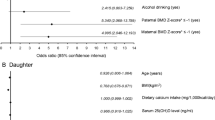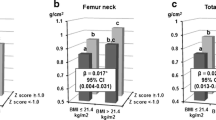Abstract
Introduction
Whether the femoral neck bone mineral density (FN BMD) of children may be better predicted from that of their parents when taking into account the anthropometry of the children was assessed in a healthy adult sample consisting of 86 mother-daughter, 32 mother-son, 32 father-daughter, and 23 father-son pairs from 128 families. Heritability for FN BMD, which is considered to be a measurement of general resemblance, was defined as the regression coefficient of the mean of the parents’ BMD. Among the anthropometric factors, lean mass was the most strongly associated with FN BMD following the adjustment for age in women (r=0.52, p<0.0001) and men (r=0.25, p=0.02). After adjustment for age, calcium intake, physical activity, and menopause and hormonal replacement therapy if relevant, heritability estimates (h2) for FN BMD were 0.68±0.23 [95% credible interval (CI): 0.15–0.99] in father-daughter pairs, 0.40±0.17 (95% CI: 0.08–0.74) in mother-daughter pairs, and 0.19±0.15 (95% CI: 0.01–0.57) in father-son pairs. Adjustment for lean mass of children increased the h2 for FN BMD in mother-son pairs [from 0.24±0.17 (95% CI: 0.01–0.57) to 0.66±0.18 (95% CI: 0.26–0.95)]. The present results show that FN BMD is heritable in adult father-daughter pairs (7.2% of a daughter’s FN BMD variance was explained by the father’s FN BMD) and that taking into account the lean mass of sons might improve the prediction of their FN BMD based on that of their mother’s (reduction of sons’ FN BMD residual variance by 5.1%). Taking the lean mass of children into account might improve the prediction of their FN BMD by 9.1% in daughters and by 18.1% in sons, irrespective of their parent’s FN BMD. These results, obtained using a Bayesian regression model, have to be confirmed in further studies involving a greater number of adult parent-offspring pairs of both genders before extrapolation to clinical practice.


Similar content being viewed by others

References
Dargent-Molina P, Favier F, Grandjean H, Baudoin C, Schott AM et al (1996) Fall-related factors and risk of hip fracture: the EPIDOS prospective study. Lancet 348:145–149
Nordin BEC (1996) International patterns of osteoporosis. Clin Orthop 45:17–30
Pocock NA, Eisman JA, Hopper JL, Yeates MG, Sambrook PN, Eberl S (1987) Genetic determinants of bone mass in adults. A twin study. J Clin Invest 80:706–710
Slemenda CW, Christian JC, Williams CJ, Norton JA, Johnston CC Jr (1991) Genetic determinants of bone mass in adult women: a reevaluation of the twin model and the potential importance of gene interaction on heritability estimates. J Bone Miner Res 6:561–567
Young D, Hopper JL, Nowson CA, Green RM, Sherwin AJ, Kaymakci B, Smid M, Guest CS, Larkins RG, Wark JD (1995) Determinants of bone mass in 10- to 26-year-old females: a twin study. J Bone Miner Res 10:558–567
Seeman E, Hopper JL, Young NR, Formica C, Goss P, Tsalamandris C (1996) Do genetic factors explain associations between muscle strength, lean mass, and bone density? A twin study. Am J Physiol 270:E320–E327
Arden NK, Spector TD (1997) Genetic influences on muscle strength, lean body mass, and bone mineral density: a twin study. J Bone Miner Res 12:2076–2081
Howard GM, Nguyen TV, Harris M, Kelly PJ, Eisman JA (1998) Genetic and environmental contributions to the association between quantitative ultrasound and bone mineral density measurements: a twin study. J Bone Miner Res 13:1318–1327
Flicker L, Hopper JL, Rodgers L, Kaymacki B, Green RM, Wark JD (1995) Bone density determinants in elderly women: a twin study. J Bone Miner Res 10:1607–1613
Nguyen TV, Howard GM, Kelly PJ, Eisman JA (1998) Bone mass, lean mass, and fat mass: same genes or same environments? Am J Epidemiol 147:3–6
Karasik D, Cupples LA, Hannan MT, Kiel DP (2003) Age, gender, and body mass effects on quantitative trait loci for bone mineral density: the Framingham study. Bone 33:308–316
Liu PY, Qin YJ, Zhou Q, Recker RR, Deng HW (2004) Complex segregation analyses of bone mineral density in Chinese. Ann Hum Genet 68:154–164
Krall EA, Dawson-Hughes B (1993) Heritable and life-style determinants of bone mineral density. J Bone Miner Res 8:1–9
Jouanny P, Guillemin F, Kuntz C, Jeandel C, Pourel J (1995) Environmental and genetic factors affecting bone mass: similarity of bone density among members of healthy families. Arthritis Rheum 38:61–67
Ferrari S, Rizzoli R, Slosman D, Bonjour JP (1998) Familial resemblance for bone mineral mass is expressed before puberty. J Clin Endocrinol Metab 83:358–361
Nordström P, Lorentzon R (1999) Influence of heredity and environment on bone density in adolescent boys: a parent-offspring study. Osteoporos Int 10:271–277
Jones G, Nguyen TV (2000) Associations between maternal peak bone mass and bone mass in prepubertal male and female children. J Bone Miner Res 15:1998–2004
Soroko SB, Barrett-Connor E, Edelstein SL, Kritz-Silverstein D (1994) Family history of osteoporosis and bone mineral density at the axial skeleton: the Rancho Bernardo study. J Bone Miner Res 9:761–769
Cohen-Solal ME, Baudoin C, Omouri M, Kuntz D, De Vernejoul MC (1998) Bone mass in middle-aged osteoporotic men and their relatives: familial effect. J bone Miner Res 13:1909–1914
Danielson ME, Cauley JA, Baker CE, Newman AB, Dorman JS, Towers JD, Kuller LH (1999) Familial resemblance of bone mineral density (BMD) and calcaneal ultrasound attenuation: The BMD in mothers and daughters study. J Bone Miner Res 14:102–110
Baudoin C, Cohen-Solal E, Beaudreuil J, De Vernejoul MC (2002) Genetic and environmental factors affect bone density variances of families of men and women with osteoporosis. J Clin Endocrinol Metab 87:2053–2059
Krall EA, Dawson-Hughes B (1995) Soft tissue body composition: familial resemblance and independent influences on bone mineral density. J Bone Miner Res 10:1944–1950
Vuillemin A, F, Denis G, Huot J, Jeandel C (2000) A computer-assisted assessment of lifetime physical activity: reliability and validity of the QUANTAP software. Rev Epidemiol Santé Publique 48:157–167
Fardellone P, Sebert JL, Bouraya M, Bonidan O, Leclercq G, Doutrellot C, Bellony R, Dubreuil A (1991) Evaluation de la teneur en calcium du régime alimentaire par autoquestionnaire fréquentiel. Rev Rhum Mal Osteoartic 58:99–103
Jacquard A (1983) Heritability: one word, three concepts. Biometrics 39:465–477
Spiegelhalter DJ, Best NG, Carlin BP, van der Linde A (2002) Bayesian measures of model complexity and fit. J R Stat Soc Ser B Stat Methodol 64:583–639
Ulrich CM, Georgiou CC, Snow-Harter CM, Gillis DE (1996) Bone mineral density in mother-daughter pairs: relations to lifetime exercise, lifetime milk consumption, and calcium supplements. Am J Clin Nutr 63:72–79
Pérusse L, Tremblay A, Leblanc C, Bouchard C (1989) Genetic and environmental influences on level of habitual physical activity and exercise participation. Am J Epidemiol 129:1012–1022
Arden NK, Baker J, Hogg C, Baan K, Spector TD (1996) The heritability of bone mineral density, ultrasound of the calcaneus and hip axis length: a study of postmenopausal twins. J Bone Miner Res 11:530–534
Walsh A (2001) Quantitative genetics. Encyclopedia of life sciences. Nature Publishing Group, UK, pp 1–7
Brown MA (2005) Genetic studies of osteoporosis. A rethink required. Calcif Tissue Int 76:319–325
Acknowledgements
The authors are very grateful to B. Martin for assistance in data collection, J.L. Foulley for methodological support, and S. L. Salhi, PhD, for presubmission editorial assistance. This work was supported by a research grant from the French Ministry of Health.
Author information
Authors and Affiliations
Corresponding author
Additional information
An erratum to this article can be found at http://dx.doi.org/10.1007/s00198-006-0163-5
Appendices
Appendix A. Unified formulation of heritability regression
Given the following equations
with \(\varepsilon _{{i1}} \tilde{}{\text{N}}{\left( {0,\sigma ^{2}_{1} } \right)}\) and \(\varepsilon _{{i2}} \tilde{}{\text{N}}{\left( {0,\sigma ^{2}_{2} } \right)}\)the three equations describe the distribution of the centered BMD variable in the population, respectively, when (i) the parents’ measurements are unknown (Eq. 1), (ii) only those of the father is known (Eq. 2), and (iii) when the two measurements are available (Eq. 3).
Equation (2) holds symmetrically when the mother’s measurement is the only one available.
Expressing a from h2
From model 3 we can write
Making the assumption that the residuals ɛ I2 are independent of the BMD variable, it follows that
From model 2, it follows that
Finally, from 4 and 5, we get
Expressing \(\sigma ^{2}_{1}\) and \(\sigma ^{2}_{2}\) from \(\sigma ^{2}_{0}\) and h2
Replacing a in Eq. (2) gives \(y_{i} = \frac{{h^{2} }} {2}y^{{{\left( f \right)}}}_{i} + \varepsilon _{{i1}}\).
This result is rather counter-intuitive, as it means that if we do not consider the residuals of models 2 and 3, Eq. (3) resolves to Eq. (2) by setting the mother’s value to 0. In fact that loss of information results in an increase of the residual variance as seen below.
Indeed, from Eq. (2), \(\operatorname{\rm var} {\left( {y_{i} } \right)} = \frac{{h^{4} }} {4}\operatorname{\rm var} {\left( {y^{{{(f)}}}_{i} } \right)} + \sigma ^{2}_{1}\).
And from Eq. (1) \(\operatorname{\rm var} {\left( {y_{i} } \right)} = \operatorname{\rm var} {\left( {y^{{{(f)}}}_{i} } \right)} = \sigma ^{2}_{0}\).
It follows that
In the same way, considering Eq. (3) leads to
The relative reduction in residual variance based on knowledge of the value of a parent is \(\frac{{h^{4} }} {4}\).
Finally, we can synthesize Eqs. (1), (2), and (3) in a unique formulation
where \(\left\{ {\begin{array}{*{20}c} {I_{m} {\left( i \right)} = 0{\text{ if }}y^{{{\left( m \right)}}}_{i} {\text{ is missing,}}} \\ {I_{m} {\left( i \right)} = 1{\text{ otherwise}}} \\ \end{array} } \right.\) and \(\left\{ {\begin{array}{*{20}c} {y^{{{\left( m \right)}*}}_{i} = 0{\text{ if }}y^{{{\left( m \right)}}}_{i} {\text{ is missing,}}} \\ {y^{{{\left( m \right)}*}}_{i} = y^{{{\left( m \right)}}}_{i} {\text{ otherwise}}} \\ \end{array} } \right.\) and \(\left\{ {\begin{array}{*{20}c} {I_{f} {\left( i \right)} = 0{\text{ if }}y^{{{\left( f \right)}}}_{i} {\text{ is missing,}}} \\ {I_{f} {\left( i \right)} = 1{\text{ otherwise}}} \\ \end{array} } \right.\) and \(\left\{ {\begin{array}{*{20}c} {y^{{{\left( f \right)}*}}_{i} = 0{\text{ if }}y^{{{\left( f \right)}}}_{i} {\text{ is missing,}}} \\ {y^{{{\left( f \right)}*}}_{i} = y^{{{\left( f \right)}}}_{i} {\text{ otherwise}}} \\ \end{array} } \right.\)
Different heritability parameters depending on the gender of the parents and the sibs
Let us denote h11, h12, h21, and h22 heritability parameters of the father-son, father-daughter, mother-son, and mother-daughter pairs, respectively.
It can be shown, in a similar way as above, that model 6 becomes
where s(i) takes the value of 1 if individual i is a man, 2 if i is a woman.
Appendix B
The Winbugs program to implement model 7 is given below:
model
{
for(i in 1:n)
{
y[i] ∼ dnorm(mu[i],tau.i[i])
mu[i]<− m + h2.f[sexe[i]]/2*(y.f[i]−m)*I.f[i] + h2.m[sexe[i]]/2*(y.m[i]−m)*I.m[i]
tau.i[i]<- tau/(
1−pow(h2.f[sexe[i]],2)*I.f[i]/4−pow(h2.m[sexe[i]],2)*I.m[i]/4)
res[i]<− y[i] − mu[i]
}
# priors
m ∼ dnorm(0.0,1.0E-6)
h2.f[1] ∼ dunif(0.0,1.0) # father-son
h2.f[2] ∼ dunif(0.0,1.0) # father-daughter
h2.m[1] ∼ dunif(0.0,1.0) # mother-son
h2.m[2] ∼ dunif(0.0,1.0) # mother-daughter
tau ∼ dgamma(0.001,0.001)
sigma<- 1 / sqrt(tau)
# signification levels
# ( =2*min(p,1−p) )
p.h2.f[1]<− step(h2.f[1])
p.h2.f[2]<− step(h2.f[2])
p.h2.m[1]<− step(h2.m[1])
p.h2.m[2]<− step(h2.m[2])
}
Note that all distributions in Winbugs are parameterized in precision (the inverse of the variance).
Data file extract:
list(
sexe=c(1, 2, 2, 1, 2, 1, 2, 2, 2, 2, 2, 2, 2, 2, 2, 2, 2, 2, 1, 2, 2, 2, 2,...
y=c(0.724, 0.637, 0.727, 0.893, 0.957, 1.101, 1.015, 1.073, 1.012, 0.767,...
y.p=c(0, 0, 0, 0, 0.893, 0.893, 0, 0, 0, 0, 0, 0, 0, 0, 0, 0, 0, 0, 0,...
y.m=c(0, 0, 0, 0.727, 0.767, 0.767, 0.727, 1.015, 0.727, 0, 0, 0, 0.851, 0,...
I.m=c(0, 0, 0, 1, 1, 1, 1, 1, 1, 0, 0, 0, 1, 0, 1, 1, 1, 1, 0, 0, 0, 0, 0,...
I.p=c(0, 0, 0, 0, 1, 1, 0, 0, 0, 0, 0, 0, 0, 0, 0, 0, 0, 0, 0, 1, 1, 0, 0,...
n=301)
Rights and permissions
About this article
Cite this article
Blain, H., Vuillemin, A., Guillemin, F. et al. Lean mass plays a gender-specific role in familial resemblance for femoral neck bone mineral density in adult subjects. Osteoporos Int 17, 897–907 (2006). https://doi.org/10.1007/s00198-005-0062-1
Received:
Accepted:
Published:
Issue Date:
DOI: https://doi.org/10.1007/s00198-005-0062-1



